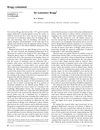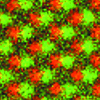Bragg centennial – celebrating 100 years of X-ray crystallography
 |
When William Lawrence Bragg outlined the foundations of X-ray crystallography to the Cambridge Philosophical Society in late 1912, he set a ball rolling that is still gathering speed today. Commemorating this landmark scientific event, this special issue of Acta Crystallographica Section A contains a collection of papers contributed by speakers at the Bragg Centennial Symposium held in Adelaide in December 2012. This symposium explored some of the historical context and personal links to the work of Lawrence Bragg and his father, William Henry Bragg, as well as featuring some of the broader scientific and social impact of their achievements. We have made these articles freely available and hope you enjoy reading this fascinating and affectionate tribute to one of the founding fathers of the IUCr and Acta Crystallographica. See also the previous special issue: Laue centennial – 100 years of X-ray diffraction. |
 |
Speakers and organizers at the Bragg Centennial Symposium, University of Adelaide, 6 December 2012.
|


![[HTML version]](http://journals.iucr.org/a/graphics/htmlborder.gif)
![[PDF version]](http://journals.iucr.org/a/graphics/pdfborder.gif)











